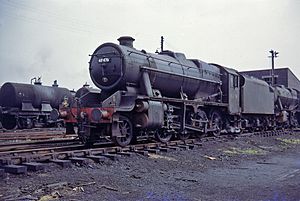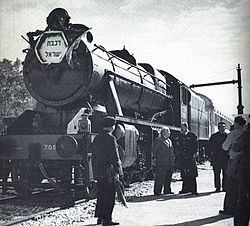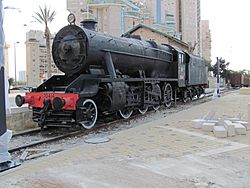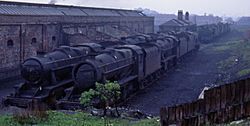LMS Stanier Class 8F facts for kids
Quick facts for kids LMS Stanier Class 8F |
|
 |
|
| Stanier 8F No. 48476 at Lostock Hall shed, late July 1968 | |
| Power type | Steam |
|---|---|
| Designer | William Stanier |
| Builder |
|
| Build date | 1935–1946 |
| Total production | 852 |
| Configuration | 2-8-0 |
| UIC classification | 1′D h2 |
| Gauge | 4 ft 8 1⁄2 in (1,435 mm) standard gauge |
| Leading wheel diameter | 3 ft 3+1⁄2 in (1.003 m) |
| Driver diameter | 4 ft 8+1⁄2 in (1.435 m) |
| Wheelbase | 52 ft 7+3⁄4 in (16.046 m) |
| Length | 63 ft 0+1⁄2 in (19.22 m) |
| Locomotive weight | 72.10 long tons (73.26 t; 80.75 short tons) |
| Fuel type | Coal |
| Fuel capacity | 9 long tons (9.1 t; 10.1 short tons) |
| Water capacity | 4,000 imp gal (18,000 L; 4,800 US gal) |
| Boiler | LMS type 3C |
| Boiler pressure | 225 lbf/in2 (1.55 MPa) |
| Fire grate area | 28+1⁄2 sq ft (2.65 m2) |
| Heating surface: Tubes | 1,479 sq ft (137.4 m2) |
| Heating surface: Firebox | 171 sq ft (15.9 m2) |
| Superheater area | 215–245 sq ft (20.0–22.8 m2) |
| Cylinders | Two, outside |
| Cylinder size | 18+1⁄2 in × 28 in (470 mm × 711 mm) |
| Tractive effort | 32,440 lbf (144.30 kN) |
| Power class | LMS & BR: 7F, later 8F |
| Axle load class | Route Availability 6 |
| Withdrawn | BR: 1960–1968 |
| Disposition | 12 preserved, 2 dumped in Turkey but still extant, 1 parts donor, 23 lost at sea, remainder scrapped |
The London, Midland and Scottish Railway (LMS) Stanier Class 8F is a type of steam locomotive. These powerful trains were made to pull very heavy freight. Between 1935 and 1946, 852 of them were built. They were designed by William Stanier and were a freight version of his successful Black Five passenger trains. The 8F locomotives were used a lot overseas during and after the Second World War.
Contents
Why the 8F Locomotives Were Built
Before the 8F, the LMS railway had trouble moving heavy goods. Their older trains were not powerful enough. They often had to use two smaller trains to pull one load. This was not very efficient.
The 8F trains were designed to fix this problem. They used a similar engine design to the popular Black Fives. This made them strong and reliable. At first, they were called "7F" trains, but this was later changed to the more familiar "8F."
When World War II started, the 8F design was chosen to be the main freight train for the country. This was because they were so good at hauling heavy loads. The War Department ordered many 8Fs to be built. They also took over some that were already made. Production for the War Department continued until 1943. After that, a cheaper train, the WD Austerity 2-8-0, was introduced. However, 8F production for use in Britain continued until 1946.
How Many 8Fs Were Built
A total of 852 Stanier Class 8F locomotives were built between 1935 and 1946. Many different companies helped build them. The London, Midland and Scottish Railway (LMS) ordered 331 of these trains. The War Department ordered 208. The Railway Executive Committee ordered 245, and the London and North Eastern Railway (LNER) ordered 68.
Some of the trains built for the War Department were loaned to British railway companies. This happened when the War Department didn't need them right away. After the war, many of these trains were sold to other countries or to British Railways.
8Fs Serving Overseas

The War Department first ordered 8Fs to help the British army in France. But they arrived after France had fallen. So, most of them ended up serving in other countries during the war. They were used in places like Egypt, Palestine, Iran, and Italy. After the war, many of these trains were sold to the local railway companies in those countries. Some were also sold to Turkey and Iraq.
8Fs in Egypt
Egypt received 42 8Fs between 1941 and 1942. Some of these trains were lost at sea on their way there. The trains were used by the British army and also loaned to the Egyptian State Railways (ESR). Operating steam trains in the desert was hard because of the lack of water. Also, their smoke could attract enemy planes. So, when American diesel trains arrived, the 8Fs were used less. Most of them were sold to ESR.
Later, more 8Fs came to Egypt from Iran. After the war, many of these military trains were no longer needed. They were sold to British Railways, Palestine Railways, or ESR. ESR bought a total of 62 8Fs and used them until 1963.
8Fs in Iran
After Iran was occupied in 1941, the War Department needed trains to move supplies to the Soviet Union. This supply route was called the Persian Corridor. About 163 8Fs were sent to Iran in 1941-42, but some were lost at sea. The trains that arrived were used by the Trans-Iranian Railway.
When American trains arrived, many 8Fs were no longer needed. So, 50 of them were sent to Egypt. After the war, even more were sent to Egypt and Iraq. The remaining 8Fs in Iran were taken out of service by 1963.
8Fs in Iraq
Ten 8Fs were sent from Iran to Iraq in 1946-47. They were bought by the Iraqi State Railways. Two more were bought in 1948. These trains became known as Iraqi Class TD and were used until the 1970s. One of these trains, number 1429, was still in Baghdad in 2014.
8Fs in Italy
Fifteen 8Fs that had been in Iran were moved to Italy in 1944. After the war, they were sold to Ferrovie dello Stato, Italy's state railway. They were used there until the early 1950s.
8Fs in Palestine and Israel
Some 8Fs were loaned to Palestine Railways in 1942. More arrived from Iran in 1944. In 1947, 24 8Fs were sold to Palestine Railways. After the 1948 Arab-Israeli War, 23 of these trains were taken over by Israel Railways. They were used until 1958. One 8F was left behind after the war and was later scrapped around 1973.
8Fs in Turkey
Twenty-five new 8Fs were sold to Turkish State Railways (TCDD) in 1941. However, seven of these were lost at sea. Two more trains were delivered in 1943, making a total of 20. These trains were called the TCDD 45151 Class and were used until the 1980s.
8Fs Used in the UK
When the 8Fs were no longer needed for the war in France, they were loaned to British railway companies. However, by late 1941, many were needed overseas. So, all the completed 8Fs were sent for military service. The War Department also took over 50 more trains from the LMS.
By 1942, the need for trains overseas was met. The last 24 new 8Fs stayed in the UK, on loan to the LMS. Also, nine damaged trains that couldn't go overseas remained in the UK. Some of these were sold to Turkey, and others were sold to the LMS.
In 1952, five 8Fs returned to the UK from Egypt. They were in bad condition but were fixed up for use by the Longmoor Military Railway. Three of these were later sold to British Railways. The other two were scrapped in 1959, ending the War Department's use of 8F trains.
Accidents and Incidents
Like all machines, these trains sometimes had accidents. Here are a few examples:
- On January 21, 1941, train No. 8247 went off the tracks in Scotland.
- On July 2, 1941, train WD 407 (LMS 8293) was involved in a head-on crash in Slough, England. Five people died, and 21 were hurt. The train was badly damaged but was repaired.
- On May 8, 1954, train No. 48462 was pulling a freight train that broke apart and went off the tracks in Plumpton, England.
- On February 9, 1957, train No. 48188 had a brake failure. It crashed into another freight train and a passenger train in Chapel-en-le-Frith, England. The staff managed to get the passengers off the train before the crash. The driver, John Axon, stayed with the runaway train and was sadly killed. He was later given the George Cross for his bravery.
- In 1959, train No. 48193 accidentally ran into a turntable pit in Kirkby in Ashfield.
- On June 17, 1960, train No. 48616 crashed into some empty coaches, went off the tracks, and rolled down a bank. No one was hurt, and the train was later scrapped.
- On August 14, 1964, train No. 48734 crashed into oil tankers in Didcot. Eleven tankers caught fire, and the train was badly damaged and later scrapped.
8Fs in British Civilian Use
'The Big Four' Railways
The London Midland and Scottish Railway built about 331 8Fs between 1935 and 1945. Other railway companies like the London and North Eastern Railway, Great Western Railway, and Southern Railway also built 245 8Fs for the LMS. The LNER even bought 68 8Fs for its own use, but these were later sold to the LMS after the war.
British Railways
When Britain's railways were taken over by the government in 1948, 624 8Fs became part of British Railways. More were bought from the Middle East Forces and the Longmoor Military Railway later on. This brought the total number of 8Fs in British Railways to 666. Most of these trains were used in the London Midland area.
When 8Fs Were Retired
The 8Fs were very successful and strong trains for British Railways. All 666 of them were still in use until 1960. They started to be retired from service in 1964. The first one was retired in 1960, and most of the others were retired between 1964 and 1968. About 150 of them were still running in the very last year of steam trains on British Railways.
Some of the later 8Fs had yellow stripes painted on their cabs. This meant they couldn't travel south of Crewe. This was because new electric wires had been put up, and these trains were too tall to fit safely under them.
Preserved 8Fs
Today, 14 Stanier 8F locomotives have been saved and preserved. Six of these are in the UK. One was used for parts to help restore other trains. None of the 8Fs built before the war were saved.
Three 8Fs have been brought back to the UK from Turkey. One of these was later sent to a museum in Israel. Two of the Turkish 8Fs were even featured on a TV show called "Monster Moves." They were moved 850 miles across Turkey!
Of the preserved trains, most of the ones in Britain have been made to run again. Two of them, Nos. 48151 and 48773, have even run on the main railway lines. However, as of 2023, none of the 8Fs are currently running on the main lines.
Some preserved 8Fs have stars on their cabs. This means they have special wheels that allow them to run faster. Another interesting fact is that British 8Fs had their driver's controls on the left side, like most LMS trains. But the ones sent to Turkey and other countries had their controls on the right side.
Here are some of the preserved 8Fs:
- 48151 (originally LMS 8151): Located at the West Coast Railway Company in Carnforth. It is currently being repaired.
- 48173 (originally LMS 8173): Located at the Churnet Valley Railway. It is being restored.
- 48773 (originally LMS 8233, also WD 307): Located at the Severn Valley Railway. It is on display, waiting for repairs.
- 48305 (originally LMS 8305): Located at the Great Central Railway. It is currently running!
- 48431 (originally LMS 8431): Located at the Keighley and Worth Valley Railway. It is on display. This is the only surviving 8F built at Swindon Works.
- 48624 (originally LMS 8624): Located at the Great Central Railway. It is being repaired. This is the only surviving 8F built at Ashford Works.
- 45153 (originally WD 357): Located in Turkey, stored.
- 8274 (originally WD 348, also TCDD 45160): Located at the Great Central Railway (Nottingham). It is stored. This train was exported to Turkey and later returned to the UK.
- 45161 (originally WD 522): Located in Turkey, on display at the Çamlık Railway Museum.
- 45165 (originally WD 353): Located in Turkey, stored.
- 45166 (originally WD 341): Located at the Be'er Sheva Turkish Railway Station in Israel, on display.
- 45168 (originally WD 340): Located in Turkey, on display in İzmit old railway station.
- 45170 (originally WD 554): Located at the Bo'ness and Kinneil Railway. It is stored, waiting for restoration. It has been named "Sir William McAlpine."
- 547 (originally WD 547): Located in Baghdad, Iraq, stored.
Sadly, locomotive No. 48518 (originally LMS 8518) was the only surviving 8F built by the LNER. It was used for parts to help build other new trains and was taken apart in 2013.
Images for kids
-
48392 and 48216 at Water Orton
-
Preserved 8624 on the Great Central Railway
-
48773 at Bridgnorth shed on the Severn Valley Railway
See also
- SS Thistlegorm


















